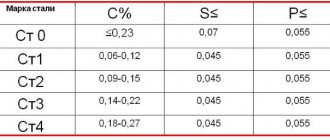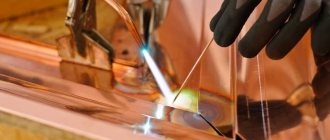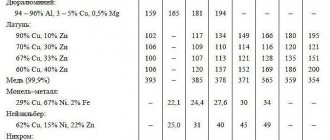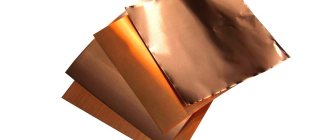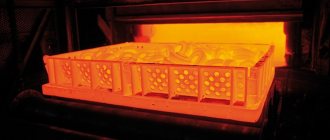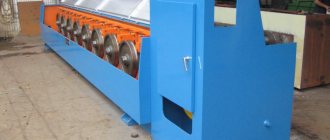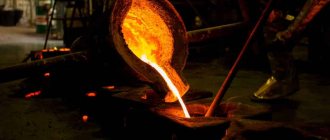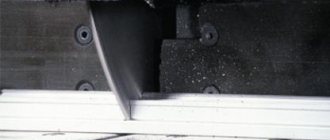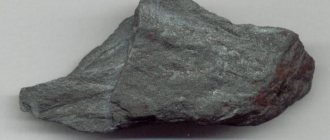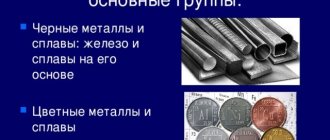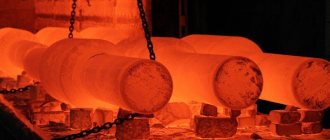Non-ferrous is a group of different metals and their alloys.
Let's take a closer look at what non-ferrous metal scrap is.
There are two groups of metals:
- colored;
- black.
Iron and its alloys are called black
The rest are non-ferrous or non-ferrous.
Their list is diverse:
- aluminum;
- copper;
- nickel;
- manganese;
- titanium;
- zirconium, etc.
are in demand today both in production and in scientific activities . Their areas of application are varied.
Scrap metal collection points are happy to buy non-ferrous metal scrap at competitive prices, and in order to avoid getting into trouble when handing it over, you need to be familiar with the types and know the standard classification of non-ferrous metals.
Classification of non-ferrous metals according to GOST
The current GOST 1639-2009 clearly indicates what belongs to non-ferrous metal scrap.
The classification of scrap is divided into four main sections that characterize it:
- Name;
- physical parameters;
- chemical composition;
- quality.
GOST metals and their alloys.
The section displays 13 types that are accepted in organizations for receiving recyclable materials.
Below is a table in which you can see a list of non-ferrous metals in one list and the number of individual types of scrap:
| Metal | Types of scrap |
| Aluminum | 32 |
| Tungsten | 17 |
| Cadmium | 2 |
| Cobalt | 3 |
| Magnesium | 8 |
| Copper | 13 |
| Brass | 23 |
| Bronze | 15 |
| Molybdenum | 9 |
| Lead | 11 |
| Mercury | 6 |
| Tin | 10 |
| Nickel | 26 |
Pure metal can rarely be found , since most scrap is made up of alloys.
Upon acceptance, belonging to one or another type is assessed by the element that is greater in percentage terms in recyclable materials.
This ratio can be determined using special equipment.
Titanium alloys
US alloys Grade (grade, grade) comes in front For aviation alloys supplied under AMS (Aircraft Materials Specification), numbers and letter suffixes characterize the nominal composition of the alloy. Grades of technical titanium are marked with the letters CP and numbers indicating the yield strength in ksi (6.9 N/mm2). For military alloys supplied according to MIL (military specification), the letter indices A , AB and B characterize the phase composition of the alloys (α, α+β, β), followed by their serial numbers. Alloys used in the manufacture of rod and wire electrodes for welding and supplied in accordance with the AWS (American Welding Society) standard are marked with the word ERTi and the alloy serial number (for grades of technical titanium) or a combination of numbers and letter indices reflecting the nominal composition of the alloy.
UK alloys supplied according to BS standards (British Standard, Aviation Series), the letter indices in the brand characterize the alloying system, and for grades of technical titanium the letters CP and tensile strength are given in N/mm2; for alloys supplied according to the standards of IMI, which is the main titanium manufacturer in the UK, the letters in the brand indicate the company index and the alloy reference numbers.
German alloys supplied according to DIN and WL (standard for aircraft materials), the index Ti , followed by alphabetic and digital symbols characterizing the nominal chemical composition (for alloys) or serial numbers (for grades of technical titanium), as well as conventional numbers included in coding system.
French alloys supplied by AESMA (Association of European Manufacturers for the Aircraft Industry), the Ti and conventional coding numbers are given; for alloys supplied according to AIR (French Aviation Standard), the letter T and yield strength values in ksi (for grades of technical titanium) or conventional alphabetic and numerical symbols characterizing the composition of the alloy (for alloyed alloys).
Japanese alloys supplied under JIS, the word “ class ” is placed in front, followed by the serial number of the alloy; for aviation alloys supplied according to proprietary standards - digital and letter indices according to a system similar to that adopted by AMS.
Along with properties, an important criterion for the quality of semi-finished products from titanium alloys is the nature of their structure. Despite some differences in the principles of its assessment and the requirements established in Russian and foreign standards, the general approach to acceptable and unacceptable structures is the same.
More complete and comprehensive information on the chemical composition and level of mechanical properties of specific semi-finished titanium alloys in certain structural states is given in the relevant standards.
Types
Non-ferrous metal scrap is divided into types according to the following criteria :
- origin;
- chemical composition;
- physical state.
The origin of the scrap may be as follows:
- industrial waste;
- marriage;
- substandard;
- scrap of finished products.
The chemical composition of non-ferrous metal scrap, which is determined in the laboratory, shows which metal or alloy it belongs to.
The most valuable recyclable materials are unalloyed metals with a low content of impurities. Physical parameters are just as important when passing as chemical ones.
According to these characteristics, scrap is divided into the following classes :
- A – directly refers to scrap and lump waste;
- B – includes shavings, tangled wire and small pieces;
- B - powdered waste (mainly found only in rare metals: tungsten, cobalt, molybdenum and titanium);
- G - other recyclables.
Safety
All non-ferrous scrap must be checked for:
- presence of radiation and harmful chemical contamination;
- explosion hazard.
When transporting scrap metal, it must be accompanied by documentation on radiation and explosion safety.
The concentration of harmful substances must not exceed the values specified in GOST 12.1.005.
The Russian Ministry of Natural Resources has identified five classes of chemical, radiation and explosion hazards of non-ferrous metal scrap:
- Hazardous waste with great harm to the ecosystem. These include mercury, polonium and plutonium.
- Highly hazardous waste, the consequences of which take nature thirty years to remove. These are alloys of lead, cobalt and molybdenum.
- Moderate danger , in which it takes ten years to restore the ecology. This is scrap mixed with copper, nickel, iron, zinc, aluminum and silver.
- Low hazardous waste, removal of the consequences takes three years. This includes scrap bronze.
- Low danger , such scrap does not harm the environment. This is the most common class among colored scrap.
Due to the expected harm to humans and nature, all operations with non-ferrous scrap require a license from the points accepting secondary non-ferrous metals. Checking for all types of hazards is carried out according to the following scheme:
Marking of rolled metal products supplied to the domestic market
Depending on the type of packaging, markings can be applied directly to the products or on labels. If the product is large enough and cannot be packaged, the marking is applied directly to it. And if the products are supplied in packaging (packs, rolls, skeins), then the markings are applied to the labels.
Metal products are marked in different ways:
- Branding (manual or machine);
- Electrographing;
- Colored varnish;
- Indelible paint;
- Labels made of waterproof film.
So that the marking of those types of rolled metal products that are supplied without packaging can be easily viewed during purchase and shipment, it is applied no more than 200 mm from the edge of each workpiece, rod, sheet, strip or on the outer turn of the roll. With automatic marking, it is allowed to place the marking further away from the edge, end or edge, but no further than 500 mm.
Labels are hung in the following order:
- One label per skein;
- One label per roll;
- There are two labels per pack;
- Per bundle - one label for one of the skeins and one for the binding;
- Per stack – one label for one of the rolls and one for the stack of rolls.
Labels must be firmly attached and easy to see. They are made of reliable wear-resistant material so that they cannot be damaged or torn off during transportation and unloading. Sometimes, to keep labels safe, they are placed in special pockets.
When packaging metal products in bundles, markings are placed in two places:
- On the top sheet or strip of each pack;
- On a marking card or label attached to the pack's binding.
When automatically marking thick sheets and strips of rolled metal, it is possible to brand the side edge of the top sheet or strip of each bundle. On sheets, the marking area must be outlined with paint, bitumen or colored varnish. Highlighting markings in a contrasting color and perforating labels 10 mm from the edge for fastening with wire can be carried out on all types of metal products upon customer request.
Marking of rolled metal products packaged in bundles and not subject to packaging, if its size exceeds 30 mm and thickness 4 mm, usually contains:
- Manufacturer's company name;
- Steel grade (the symbol is deciphered in the technical document on quality);
- Heat number (the symbol is deciphered in the technical document on quality);
- Batch number;
- Size (diameter, thickness, length, width, height, profile number).
The metal marking applied to the label, the end of the roll or the edge of the sheet usually contains:
- Manufacturer's company name;
- Steel grade, group or strength class (the symbol is deciphered in the technical document on quality);
- Batch number;
- Size (diameter, thickness, length, width, height, profile number);
- The weight of a roll, skein, pack or stack of rolls, bundle of skeins.
The theoretical mass (TM) can be indicated; together with other marking details, the mass can be indicated in an additional label.
To make markings on labels reliable and clear, use:
- Labels made of metal, wood, plastic and moisture-resistant film;
- Labels with an area of at least 24 cm2;
- Clear, indelible fonts with letters 5-20mm high and 3-12mm wide.
In some cases, it is possible to deviate from the specified font size:
- When marked with paint, it can be increased to 100 mm in height and 70 mm in width;
- When marking on bars with a cross-section of less than 60 mm and tapes with a width of less than 50 mm, it can be reduced to 2-4 mm.
At the request of the consumer the following can be produced:
- Additional marking with colored paint;
- Marking of rolled metal made of mild steel with a longitudinal strip;
- Marking of rolled metal from semi-quiet steel with a transverse strip;
- Marking with branding with a predetermined font depth.
Transport marking is regulated by GOST 14192.
Marking
According to GOST, all transported scrap must be marked with the following indication:
- names;
- GOST designations;
- designations of the type of recyclable materials;
- alloy grades.
Marking of non-ferrous metals and alloys must be firmly attached to the cargo during transportation and storage.
To determine the grade of metal, you need to look at the stamp book , a special document with all the markings of the metal or alloy you are interested in.
Marking of rolled metal products supplied to the foreign market
Rolled metal supplied abroad is marked:
- In Russian – when delivered to countries that have signed the Agreement on International Freight Transport (SMGS);
- In English – to other foreign countries (if there are no other purchase orders or specification contracts).
Markings are applied:
- From two ends;
- On one longitudinal side (if it is not possible at the ends);
- On the longitudinal side and end (for sheet metal in packages);
- On the top sheet of the pack (if packaging is available);
- On each sheet (on sheet metal that is not subject to packaging);
- On a marking card measuring at least 200*290 mm;
- On a metal label for export (if it is not technically possible to apply markings to the marking card or the metal products themselves).
Labels are hung in the following order:
- For packs up to 6 m – 1 label;
- For packs over 6 m - 2 labels;
- Per skein – 1 label;
- Per roll – 1 label;
- For a bunch of skeins - 2 labels;
- There are 2 labels per stack of rolls;
- There is 1 label per coil of wire rod.
The standards for export labels are also slightly different from the requirements for labels used to mark rolled metal products for domestic sale.
Export labels with a size of at least 80*120 mm and an aspect ratio of 1:1.5 can be produced:
- from tinplate;
- galvanized thin-sheet anti-corrosion metal products;
- moisture-resistant film applied to a solid base of metal or some other dense material.
The export label must contain the following information about the metal product:
- Manufacturer's company name;
- Exporter company name;
- Contract specification;
- Destination country;
- Size of metal products (diameter, thickness, height, width, length, square side, profile number);
- Steel grade;
- Group and strength class;
- Heat and batch number (if there are several batches);
- Net and gross weight in kilograms (you can indicate the approximate weight for rolled metal products with a cross-section of less than 24 mm and not indicate the weight at all for thick sheet metal products supplied individually);
- The batch number in a fraction (may not be indicated for rolled metal products with a cross-section of less than 24 mm and for thick sheet metal products supplied individually).
Kinds
The large number of non-ferrous metals and various characteristics required their classification into separate types.
industrial systematization is in use , reflecting the historically established components of the metallurgical industry and the science of the same name.
The name itself does not fully reflect the essence of non-ferrous metal.
Only gold and copper are colored, while the rest are the usual grey-black shades.
Science usually distinguishes the following types of non-ferrous metals and alloys:
- lungs;
- heavy;
- noble;
- refractory;
- scattered;
- rare earth;
- radioactive.
industry in Russia today is on the rise and includes:
- metal mining;
- ore beneficiation;
- metal smelting
Basic non-ferrous metals
The main non-ferrous metals include:
- copper;
- aluminum.
Aluminum is an excellent electrical conductor. It is flexible, which is both its advantage and disadvantage.
To give it strength add :
- manganese;
- copper;
- magnesium, etc.
Such alloys are used for the production of :
- airplanes;
- sea and river ships;
- space shuttles;
- in construction;
- in the food industry.
Aluminum and its alloys are the cheapest type of non-ferrous metal scrap.
You can find it in a variety of household items, including:
- siding;
- gutters;
- roofing
Copper is a commonly found non-ferrous metal.
It also has good characteristics:
- plastic;
- good electrical conductor;
- good heat conductor.
It is in great demand in alloys and is used in various economic sectors.
Its alloy with zinc and tin is known - brass.
It can be found in:
- cars;
- hours;
- expensive jewelry.
find copper for scrap metal in:
- power cables;
- water pipes;
- household products.
Copper is highly valued at recycling centers.
Rare
Rare earth metals are used to improve the qualities of other metals and became widely used with the development of industrial production in the 20th century.
These are the following metals:
- scandium;
- yttrium;
- lanthanides.
The name itself suggests that there is very little of these non-ferrous metals in the earth's crust. Also, previously, refractory oxides that form rare non-ferrous metals were called “earths” . They are extracted from oxides.
Today, rare earth metals can be found in all digital devices:
- smartphones;
- players;
- computers;
- in hybrid engines;
- in other electronics.
Alloys made from them have high characteristics , for example:
- anti-corrosion;
- strength;
- heat resistant.
Heavy
Let's consider heavy non-ferrous metals, collecting them in several lists.
The heaviest non-ferrous metals on Earth:
- osmium;
- iridium.
Rarely found in soil , it is generally the most expensive non-ferrous metal.
Also included in this group are:
- copper;
- lead;
- zinc;
- tin;
- nickel.
All of them have a high density and, accordingly, a lot of weight, which is why they get the name – heavy.
Lead is widely known and used in many industries , contained in:
- rock
- soil.
It is made from:
- batteries;
- explosives;
Lead is also used to create protective aprons from radiation .
Has the following characteristics:
- low thermal conductivity;
- plastic;
- toxicity.
Therefore, lead must be used carefully, following all safety regulations.
Tin used to be called an alloy of lead and silver.
Today, tin is used in the metallurgical industry and the production of various alloys, which include:
- bearings;
- packaging foil;
- bronze;
- food tin;
- wires
Nickel is a heavy non-ferrous metal with high heat-resistant and anti-corrosion characteristics. Nickel is used in alloys. In stainless steel it is the main component.
Made from nickel :
- coins;
- armor;
- chemical equipment;
- wire;
- foil;
- a thread;
- powder;
- alkaline batteries.
in demand in:
- shipbuilding;
- electrical engineering.
Lungs
The definition of “light non-ferrous metals” includes metals with low density.
List of the most popular light non-ferrous metals:
- aluminum;
- tin;
- magnesium;
- titanium;
- beryllium;
- lithium.
The lightest non-ferrous metal is lithium. It is widely used in various alloys.
is used in:
- chemical industry;
- metallurgical industry;
- military-industrial complex;
- thermonuclear energy.
Lithium is also used in the manufacture of:
- optics;
- alkaline batteries;
- ceramic products.
The ductility of magnesium is not as good as that of copper and aluminum, which affects the welding properties of this metal. But it can be easily cut with a special tool. At the same time, the mechanical properties leave much to be desired. This it to be widely introduced into industrial production .
Marking of non-ferrous metals and alloys
Non-ferrous metals are more expensive and scarce compared to ferrous metals, but their scope in industry is constantly expanding. The most widely used alloys are based on aluminum, copper, magnesium, and titanium.
To designate elements contained in non-ferrous metals and alloys, the following capital letters of the Russian alphabet are accepted:
A - aluminum, B - beryllium, F - iron, K - silicon, Kd - cadmium, Mts - manganese, M - copper, Mg - magnesium, Msh - arsenic, N - nickel, O - tin, C - lead, Su - antimony, C - zinc, F - phosphorus, T - titanium.
Aluminum and its alloys
Depending on the degree of purity, primary aluminum is divided into three classes : special purity A999 (99.999% Al), high purity A995, A99, A97, A95 (99.995 ... 99.95% Al) and technical purity A85, A8, A7, A7E, A6, A5, A5E, A0 (99.85 ... 99.0% Al) – GOST 11069-74. The letter E indicates that aluminum has guaranteed electrical performance.
As permanent impurities
Aluminum contains iron, silicon, copper, manganese, zinc and titanium.
The main alloying elements
are copper, magnesium, silicon, manganese, zinc, and less commonly nickel, beryllium, etc.
Aluminum alloys are classified according to manufacturing technology
,
heat treatment ability and properties
.
All aluminum alloys can be divided into three groups : wrought, cast and sintered (produced by powder metallurgy).
Wrought aluminum alloys non-hardening and hardening alloys
heat treatment.
For deformable aluminum alloys that are not hardened
include alloys of the AI - Mn and AI - Mg systems.
GOST 4784-97 defines grades of non-hardening deformable aluminum and its alloys
(and comparing them with brands according to international standards ISO 209-1):
aluminum - AD000(A199.8), AD00(A199.7), AD00E(EA199.7), AD0(A199.5), etc.;
Al–Mn system - MM (AlMnMg0.5), AMts, AMtsS, D12 (AlMn1Mg1). Composition of MM alloys: Si = 0.6%, Fe = 0.7%, Cu = 0.3%, Mn = 1.0-1.5%, Mg = 0.2-0.6%, Cr = 0.1%, Zn = 0.25%, Ti = 0.1%; AMts grade: Si = 0.6%, Fe = 0.7%, Cu = 0.05-0.20%, Mn = 1-1.5%, Zn = 0.1%.
Al - Mg system - AMg0.5, AMg1, AMg1.5, AMg2, AMg2.5, AMg3, AMg3.5, AMg4, AMg4.5, AMg5, AMg6. The numbers following the letters AMg correspond to the approximate magnesium content in these alloys. For example, the AMg1.5 alloy contains Si = 0.4%, Fe = 0.5%, Cu = 0.15%, Mn = 0.1-0.5%, Mg = 1.7-2.4% , Cr = 0.15%, Zn = 0.1%.
All other aluminum alloys are hardened by heat treatment.
Normal strength alloys
based on
the Al – Cu – Mg and Al – Cu – Mn are called duralumins (denoted by the letter D) and forging aluminum (denoted by the letters AK ). GOST 4784-97 defines the grades of duralumin : D1(AlCu4MgSi), D16(AlCuMg1), D16ch, D18, D19, D19ch, V65; grades of forging aluminum: AK6, AK8, AK4, AK4-1, AK4-1ch. The numbers indicate the conventional serial number of the alloy. Composition of alloys of grade D1: Si = 0.2-0.8%, Fe = 0.7%, Cu = 3.5-4.5%, Mn = 0.4-1.0%, Mg = 0.4 -0.8%, Ti = 0.15%, Cr = 0.1%, Zn = 0.25%; grade B65: Si=0.5%, Fe=0.2%, Cu = 3.9-4.5%, Mn = 0.3-0.5%, Mg = 0.15-0.3%, Zn = 01%, Ti = 0.1%; grade AK4: Si = 0.5-1.2%, Fe = 0.8-1.3%, Cu = 1.9-2.5%, Mn = 0.2%, Mg = 1.4-1 .8%, Ti = 0.1%, Ni = 0.8-1.3%. Alloys AK4, AK4-1, AK4-1ch are heat-resistant.
High strength
aluminum alloys
(Al – Zn – Mg systems) are designated by the letter B. GOST 4784-97 defines the grades: 1915 (AlZn4.5Mg1.5Mn), 1925 (AlZnMg1.5Mn), V93pch, V95, V95pch, V95och, V95-1, V95- 2, ATspl. The numbers indicate the conditional number of the alloy. Composition of alloy grade V95och : Si = 0.1%, Fe = 0.15%, Cu = 1.4-2.0%, Mn = 0.2-0.6%, Mg = 1.8-2.8 %, Cr = 0.1-0.25%, Zn = 5-6.5%, Ti = 0.05%.
Aluminum alloys with increased ductility and corrosion resistance
are designated by the letters
AD - deformable aluminum
.
GOST 4784-97 defines the grades (Al – Mg – Si systems) AD31 (AlMg07Si), AD31E (E-AlMgSi), AD33 (AlMg1SiCu), AD35 (AlSi1MgMn), AB (avial alloy). The numbers indicate the purity of aluminum, the letter E indicates an alloy with electrical properties. AD31 alloy composition : Si = 0.2-0.6%, Fe = 0.5%, Cu = 0.1%, Mn = 0.1%, Mg = 0.45-0.9%, Cr = 0 .1%, Zn = 0.2%.
Aluminum alloys for the manufacture of wire for cold heading are marked with the letter P: D1P, D16P, D19P, AMg5P, V95P. Alloys intended for the production of aluminum welding wire are marked with the letters Sv: SvA99, SvA97, SvA85T, SvA5, SvAMts, SvAmg3, SvAmg5, SvAmg6, SvAmg63, SvAmg61, SvAK5, SvAK10.
GOST 1583-93 divides casting aluminum alloys
Group I – based on the Al – Si – Mg system : AK12 (AL2), AK13 (AK13), AK9 (AK9), AK9s (AK9s), AK9ch (AL4), AK9pch (AL4-1), AK8l (AL34), AK7 (AK7), AK7ch(AL9), AK7pch(AL91), AK10Su(AK10Su), etc.;
Group II - Al – Si – Cu systems :
AK5Mch (AL5-1), AK5M (AL5), AK5M2 (AK5M2), AK5M7 (AK5M7), AK6M2 (AK6M2), AK5M4 (AK5M4), AK8M3 (AK8M3), AK8M3ch (VAL8), AK9M2 (AK9M2), etc.;
Group III – Al–Cu systems : AM5 (AL19), AM4.5Kd (VAL10);
Group IV – Al – Mg systems : AMg4K1.5M (AMg4K1.5M), AMg5K (AL13), AMg5Mts (AL28). AMg6l (AL23), etc.;
Group V - Al systems - other components : AK7Ts9 (AL11), ATs4Mg (AL24), AK9Ts6 (AK9Ts6), etc.
In brackets for cast aluminum alloys the designations of grades according to GOST 1583, OST 48-178 and Technical Specifications are indicated.
The letter A in brands means aluminum alloy, the remaining letters and numbers indicate the name of the alloying component and its content. At the end of the brand, the degree of purity of the alloy is sometimes indicated: ch - pure, pch - high purity, och - special purity, l - foundry.
An example of deciphering an alloy of the AK12M2MgN (AL30) brand: cast aluminum (Al-Si-Cu system), containing silicon 11 - 13% (K12), copper 1.5 - 3% (M2), magnesium 0.8 - 1.3% (Mg), nickel 0.8 - 1.3% (N), the rest is aluminum.
The marking of aluminum alloys is not systematic and uniform. Therefore, a unified four-digit marking of aluminum alloys is currently being introduced. First digit
denotes the basis of all alloys (aluminum is assigned the number 1);
the second
is the main alloying element or group of main alloying elements;
the third digit
or
the third with the second
corresponds to the old marking;
the fourth digit
- odd (including 0) indicates that
the alloy is deformable
, even - that the alloy
is cast
.
For example, alloy D1 is designated 1110, D16 - 1160, AK4 - 1140, AMg5 - 1550, AK6 - 1360, etc. Some new alloys have only digital markings : 1915, 1925, etc.
Dispersion-strengthened composite materials are used in industry
on an aluminum base.
Sintered aluminum powders - SAP-1, SAP-2, SAP-3, SAP-4 - aluminum in the form of powder or powder, strengthened by particles of aluminum oxide Al2O3. They are obtained by successive briquetting, sintering and pressing of powder oxidized from the surface of aluminum. The numbers are the conventional serial number of the alloy, but as the number increases, the Al2O3 content in the alloy, its strength, hardness and heat resistance increase. This reduces the ductility of the alloy.
Sintered aluminum alloys - SAS-1, SAS-2, where the numbers are the conventional serial number of the alloy, manufactured mainly using the same technology as SAP, instead of aluminum powder, they are based on oxidized alloys. The alloys contain 25-30% Si; 5-7% Ni; the rest is Al.
Copper and its alloys
According to GOST 859-2001, depending on the impurity content, grades of technical copper are distinguished: M00 b (99.99% Cu), M0 b (99.97% Cu+Ag), M1 b (99.95% Cu+Ag), M00 (99.96% Cu), M0 (99.93% Cu + Ag), M1 (99.90% Cu + Ag), M1p (99.90% Cu + Ag), M2 (99.7% Cu + Ag ), M3 (99.5% Cu+Ag), etc. The letter “b” at the end of the brand (M0 b ) means oxygen-free, and “p” (M1 p ) means deoxidized.
Copper forms many common alloys: brass, bronze and copper-nickel (nickel silver, nickel silver, kunial, constantan, manganin, copel, etc.).
Brasses are alloys of copper and zinc. They can be double (simple) and multicomponent (alloyed).
According to technological characteristics, brasses are divided into deformable
and
foundries
.
Double deformable brasses are marked with the letter L (brass) and a number indicating the average copper content in percent (the rest is zinc) : L96, L90, L85, L80, L70, L68, L63, L60 (GOST 15527-70*).
Brasses with a copper content of 90% or more (L96, L90) are called tompak
, at 80 - 85% copper (L85, L80) -
semi-compact.
Alloyed wrought brasses are marked with the letter L and letters indicating the name of the alloying element. The numbers, separated from each other by a dash, coming after the letters, show the content of copper (first) and alloying elements (corresponding to the letters) in percent (the rest is zinc): LAZ60-1-1, LZhMts59-1-1, LO70-1, LANKMts75-2-2.5-0.5-0.5, etc. (GOST 15527-70).
Alloyed brasses are called by their alloying additives. For example, LA77-2 is aluminum deformable brass containing 77% Cu, 2% Al (A), the rest (21%) is Zn ; LO90-1 – tin tombac containing 90% Cu, 1% Sn (O), the rest (9%) is Zn.
In brands of cast brass , the zinc content is indicated, and the amount of each alloying element is placed directly after the letter indicating its name : LTs14K3S3, LTs30A3, LTs16K4, LTs37Mts2S2K, LTs40Mts1.5, LTs40S, LTs30A3, LTs40Mts3A, etc. (GOST 17711-93).
An example of decoding the LTs23A6Zh3Mts2 brand: aluminum-ferromanganese cast brass containing 23% Zn, 6% Al, 3% Fe, 2% Mn, the rest (66%) is Cu.
Bronzes are copper alloys in which zinc or nickel are not the main alloying elements.
Based on the chemical composition, bronze is divided into tin
, in which the main alloying element is tin, and tin-free, which do not contain tin as an alloying component. Bronzes are called, like brass, by the corresponding additives.
Based on technological characteristics, bronzes are divided into cast and wrought bronzes.
.
Br come first . The rest of the alloy grade entry depends on the method of obtaining the blanks.
In cast bronzes, the designation and quantity of alloying components are made in accordance with brasses. At the end of the brand there may additionally be a capital letter L: BrO3Ts7S5N1, BrO10Ts2, BrO10F1, BrO8Ts4, BrO10S10, etc. (GOST 613-79); BrA9Mts2L; BrA10Zh4N4L, BrSu3N3Ts3S20F (Su - antimony), BrA7Mts15Zh3N2Ts2, etc. (GOST 493-79), etc.
An example of the decoding of the BrO3.5Ts7M5 brand: tin-zinc-lead cast bronze with a tin (O) 3.5%, zinc (C) 7%, lead (C) 5%, the rest (84.5%) is copper; BrA7Mts15Zh3N2Ts2 : tin-free cast bronze containing aluminum (A) 6.6-7.5%, iron (F) 2.5-3.5%, manganese (Mts) 14.0-15.5%, nickel (N) 1.5 - 2.5%, zinc (Z) 1.5 - 2.5%.
The difference between the designation of grades of wrought bronzes and cast bronzes is the same as for brasses: first, all alloying elements are written in a letter code, and then numbers separated by a dash, indicating in the same sequence the content of components in percentage: BrOF6.5-0.4, BrOTs4 -3, BrOTsS4-4-4, etc. (GOST 5017-74*); BrA5, BrAZHN10-4-4, BrBNT1.9, etc. (GOST 18175-78*), etc.
An example of decoding the BrB2 brand: tin-free beryllium deformable bronze containing 2% beryllium (B), the rest - (98%) copper; BrBNT1.7: tin-free beryllium-nickel-titanium deformable bronze containing 1.7% beryllium (B), less than 1% nickel and titanium each, the rest (about 97%) is copper.
Copper-nickel alloys are alloys in which the main alloying element is nickel.
Industrial copper-nickel alloys can be divided into two groups : structural and electrical
.
The first group includes corrosion-resistant and high-strength alloys
such as cupronickel, nickel silver, and kunial. Mn, Al, Zn, Fe, Co, Pb, etc. are added as additional alloying elements.
Marking of copper-nickel
alloys starting with the letter
M: MN19, MN25, MNZhMts 30-1-1 – cupronickel
;
MNTs15-20, MNTsS16-29-1.8 – nickel silver
;
MNA13-3, MNA6-1.5 – cunial;
MNMts40-1.5 –
constantan
;
MNMts43-0.5- kopel
;
MNMts3-12- manganin;
MNZH5-1, MNZHMts10-1-1, etc. (GOSTs 5063-73*, 5187-70*,492-73*).
Magnesium and its alloys
According to GOST 804-93, depending on the chemical composition, primary magnesium is produced in four grades: Mg80 (99.80% Mg), Mg90 (99.90% Mg), Mg95 (99.95% Mg) and Mg98 (99.98% Mg ).
GOST 14957-76 provides for the following grades of wrought magnesium alloys: MA1, MA2, MA2-1, MA5, MA8, MA11, MA12, MA14, MA15, MA19. The letters MA indicate that the magnesium alloy is deformable, and the numbers are a conventional serial number.
Cast magnesium alloys (GOST 2856-79*) are produced in the following grades: ML3, ML4, ML4pch, ML5, ML5pch, ML5on, ML6, ML8, ML9, ML10, ML11, ML12, ML15 and ML19. The letters ML indicate that the alloy is magnesium casting, the numbers indicate the serial number of the alloy, the letters “ pch ” at the end of the brand indicate an alloy of high purity, “on” means a general purpose alloy. An example of decoding the ML3 brand : cast magnesium alloy with serial number 3, containing aluminum 2.5-3.5%, manganese 0.15-0.5%, zinc 0.5-1.5%
Recently, grades of magnesium alloys have begun to be indicated using a digital code, for example: MA1-2311, MA2 - 2311, MA2-1 - 2323, etc.
Titanium and its alloys
The technical titanium obtained as a result of remelting is marked depending on the impurity content: VT1-00 (sum of impurities <0.398% - Si = 0.08%, Fe = 0.15%, O = 0.10%, N = 0.04% , C= 0.05%, H= 0.008%, others - 0.1%); VT1-0 (total impurities <0.55%), VT1-2 (total impurities > 2%).
According to manufacturing technology, titanium alloys are divided into wrought, cast and powder
.
Deformable titanium alloys of grades are produced : OT4-0, OT4-1, OT4, VT3-1, VT5, VT5-1, VT6, VT6s, VT8, VT14, VT20, VT22, PT-7M, PT-3V , AT3. The numbers behind the letters are a conventional serial number. The main alloying additives are aluminum, silicon, manganese, etc. For example, the OT4-0 contains the following alloying additives: Al = 0.4-1.4%, Zr = 0.3%, Mn = 0.5-1.3 %, Si=0.12%, Fe=0.3%; PT-7M – Al = 1.8 - 2.5%, Zr = 2.0 - 3.0%, Si = 0.12%, Fe = 0.25%; AT3 - Al = 2.0 - 3.5%, Cr = 0.2 - 0.5%, Si = 0.2 - 0.4%, Fe = 0.2 - 0.5%.
Features of the marking of cast titanium alloys are the presence of the letter L at the end of the brand designation: VT5L, VT3-1L, VT20L, etc.
For the manufacture of parts using powder metallurgy
alloys VT5, VT5-1, OT4, VT3-1, etc. are used.
The marking of powder alloys remains unchanged.
Popular types at collection points
The most popular non-ferrous metals at collection points:
- aluminum;
- copper;
- brass;
- zinc alloys (for example, TsAM);
- bronze;
- nickel;
- lead;
- titanium;
- tin;
- tungsten.
If you want to find out what is more profitable to rent out, then read this article.
